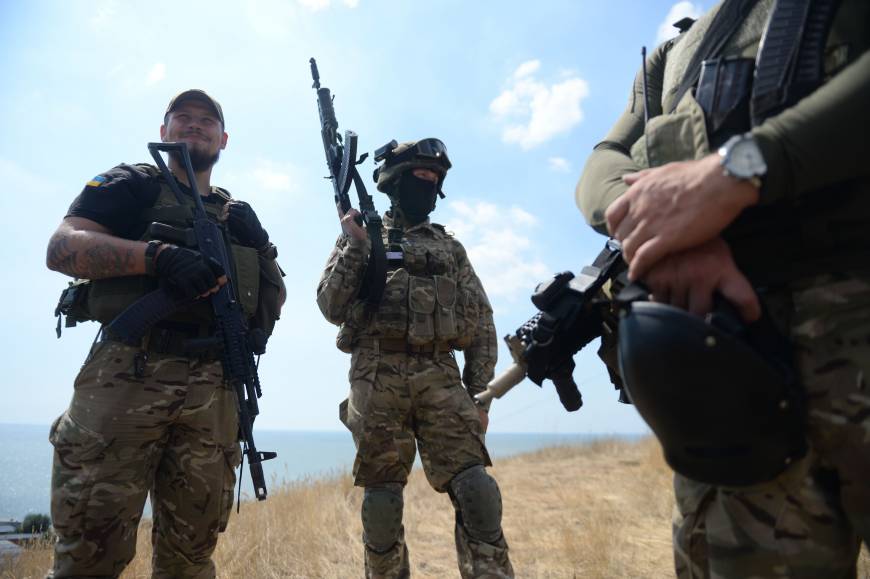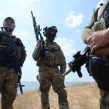
Russian Forces Target Three Key Objects in Ukraine’s East
Publication: Eurasia Daily Monitor Volume: 11 Issue: 180
By:

Beyond the newly imposed partition lines, Russian regular and irregular forces are incessantly attacking Ukrainian positions in the Debaltseve salient, the Donetsk airport, and around Mariupil on the Azov Sea. Capturing these positions—a centrally located rail and road transport hub, the international airport, and the maritime port of Donbas (eastern Ukrainian region encompassing the Donetsk and Luhansk provinces), respectively—would be fully within the logic of creating an economically and logistically sustainable, de facto state entity under Russian protection in Donbas.
Those positions were in Ukrainian hands as of the signing of the two armistice agreements, which supposedly confirmed the existing lines in the field. However, non-transparent negotiations are under way to simplify and shorten (“straighten out”) those lines through possible trade-offs.
Debaltseve is a site of railroad and highway junctions that connect Donetsk and Luhansk with each other. Supposedly, the Ukrainians would consider the possibility of exchanging the high-value Debaltseve for some Russian-held area in the Donbas. Meanwhile, Russian and local proxy forces are attacking Debaltseve, pre-empting such negotiations and breaching the ceasefire in the process.
The airport of Donetsk is the last Ukrainian toehold in that city’s vicinity. If seized by Donetsk-flagged Russian forces, the airport could pose serious problems for Ukraine in the future. It could be used for supplying Russian and local forces in the “Donetsk people’s republic” (DPR) and potentially as a springboard for operations farther afield in Ukraine. In those hands, the airport would also predictably become a hub for contraband and other illicit trafficking, likely to spread into Ukrainian-controlled territory. Since international recognition of the Donetsk “republic” is ruled out, any legitimate international use of a “DPR”-flagged airport would also be out of the question. Undoubtedly aware of this fact, the Russian side nevertheless deems the airport’s capture worth the odium of violating the ceasefire on a daily basis, with artillery and armor attacks on the besieged Ukrainian garrison.
Mariupil is the leading metallurgical and machine-building center in Ukraine’s east, as well as the maritime port serving Donbas industries writ large. Mariupil’s pivotal geographic location, industrial and logistics assets, and political significance (see EDM, September 8) have turned this city of 500,000 into a prize of the first order in Russia’s war against Ukraine. The ceasefire has saved Mariupil for now from Russian capture. Mariupil authorities (traditionally connected with the Party of Regions and the steel magnate Rinat Akhmetov) have proven fully loyal to Ukraine, preparing for a last-stand defense along with the National Guard’s Azov battalion. Russian forces currently stand some 15 kilometers eastward of Mariupil, are enveloping the city from the north, and shelling the defenders on a daily basis.
Were Mariupil with the Azov littoral to fall behind the “DPR’s” side of the armistice lines, the location would be ideal for Russia to open a land corridor westward to the recently annexed Crimea. International and Ukrainian observers widely assume that Moscow is planning along those lines, out of economic and strategic considerations.
Following the annexation of this non-contiguous peninsula, Russia must rely on the Kerch Strait ferryboat line to supply Crimea’s population of 2.5 million with foodstuffs, fuel and other basic goods. The ferryboats’ capacity is far from sufficient, however, and the service halts in winter when the sea freezes over. The Russian government has recently dusted off plans to build a road-and-rail bridge across the Kerch Strait (ITAR-TASS, October 1). However, financing this $6 billion project looks problematic, and the desired time-frame to 2018 seems dubious.
The Kremlin needs a timely solution, and the approach of winter raises the stakes. Russia apparently envisages securing an overland corridor from its Rostov oblast, along the Ukrainian littoral of the Azov Sea (crossing parts of the Donetsk, Zaporizhzhyya and Kherson provinces) to Crimea.
Moscow can consider a range of options for establishing such a corridor to Crimea as a long-term arrangement: 1) By unilateral action with a military backup, in the event of a wider crisis erupting in Ukraine’s southeast. A Russian direct thrust to Crimea would exploit the wider crisis, not initiate it, and would result in a permanent Russian-controlled corridor; 2) Again in that kind of crisis, by concluding a separate agreement between Moscow and the “DPR” or some “Novorossiya” entity; 3) By resorting to massive “humanitarian aid” convoys of the type that Russia sent to Donbas in August, unilaterally and unaccountably; 4) By agreement between the Russian and Ukrainian governments. This solution, with legal cover, would be optimal for Russia. Depending on formulations therein, such an agreement could be interpreted as Ukrainian consent to Russia’s annexation of Crimea but would, in any case, be heavily criticized in Ukraine’s political arena.
Ukrainian and Western officials are concerned about such scenarios developing even in a post-conflict stage. To cement its annexation of Crimea, the Kremlin might present a humanitarian case for the land corridor to supply Crimea’s population with life’s necessities. For its part, Kyiv could consider trading off its legal consent to such a corridor, for a Russian quid-pro-quo on some other issue. But Kyiv would lose that bargaining card, if Russia proceeds to establish such a corridor through unilateral action. Ultimately, the opening of a corridor to Crimea could embolden Russia to press for a continuation from Crimea to Odesa, linking up with Transnistria and casting its shadow over Moldova and Romania.




